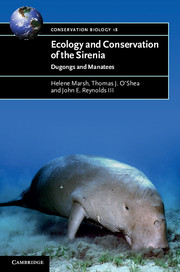Book contents
- Frontmatter
- Contents
- Foreword
- Preface
- Acknowledgements
- 1 Introduction
- 2 Steller’s sea cow
- 3 Affinities, origins and diversity of the Sirenia through time
- 4 Feeding biology
- 5 Behaviour and habitat use
- 6 Life history, reproductive biology and population dynamics
- 7 Threats
- 8 Conservation status
- 9 Conservation opportunities
- References
- List of online supplementary material
- Index
- Plate section
2 - Steller’s sea cow
Discovery, biology and exploitation of a relict giant sirenian
Published online by Cambridge University Press: 05 January 2012
- Frontmatter
- Contents
- Foreword
- Preface
- Acknowledgements
- 1 Introduction
- 2 Steller’s sea cow
- 3 Affinities, origins and diversity of the Sirenia through time
- 4 Feeding biology
- 5 Behaviour and habitat use
- 6 Life history, reproductive biology and population dynamics
- 7 Threats
- 8 Conservation status
- 9 Conservation opportunities
- References
- List of online supplementary material
- Index
- Plate section
Summary
Introduction
The culmination of the evolution of the hydrodamaline lineage in the North Pacific Ocean that began in the Miocene (Chapter 3) ended abruptly in historic times. Hydrodamalis gigas, once distributed widely around the region, was restricted to coastal fringes of two islands near the Kamchatka Peninsula of Siberia, where it was discovered by Europeans in the middle of the eighteenth century. This magnificent, though bizarre, beast was quickly exploited for its meat to supply workers in the expanding fur trade, and could not hold out for long after it was found. Perhaps typical of its time, this exploitation was wasteful and opportunistic. Given the restricted distribution, limited population and likely low rates of potential population growth (see Chapter 6 for discussion of life histories of extant sirenians), the pressures of exploitation could only be withstood by H. gigas for some 27 years before it was rendered extinct. This extinction was a great loss of a biological treasure, and is sometimes cited as a warning of the vulnerability of sirenian populations (among others) to over-exploitation. In appreciation of the uniqueness of this animal, and of the importance of the lesson its loss teaches us, we highlight the historical background to its discovery during a truly epic voyage; describe the demise of the last population; and provide a summary of both historical and modern findings regarding its biology. Over the years, previous authors have also given accounts of the sea cow’s discovery and extirpation (e.g. Goodwin 1946; Scheffer 1973; Haley 1980; Reynolds and Odell 1991; Dietz 1992; Anderson and Domning 2002). However, only one scientist ever observed and dissected Hydrodamalis gigas, and so throughout this chapter we provide the reader with excerpts of Steller’s descriptions through direct translations of his own words rather than attempt to interpret them anew.
Georg Wilhelm Steller and the Voyage of the St Peter
Steller’s sea cow (Hydrodamalis gigas) was named for Georg Wilhelm Steller, the only scientist ever to observe this extraordinary animal alive. He discovered a relict population of the giant sirenian when he was stranded with crew mates on an uninhabited island in the eastern Bering Sea in 1741. Steller was an excellent scientist of his time, particularly in botany, and was physically strong and well-suited to the spartan life of a frontier naturalist (Stejneger 1936). He was born in 1709 in Germany, where his university education emphasised theology, anatomy, medicine and botany (he eventually lectured in the last of these). His early career took him to Russia, where he changed the spelling of his name (originally Stöhler or Stöller) to better suit the Russian language (Stejneger 1936). Steller received an appointment from the Academy of Sciences at St Petersburg, which sent him to the Kamchatka Peninsula of far eastern Siberia as a botanist. Soon thereafter he joined the second expedition of Vitus Bering (for whom the Bering Sea is named) on which he served as naturalist, physician and pastor. Captain-Commander Bering was a Dane, commissioned by Peter the Great to explore passages at the eastern frontiers of Russia and beyond to North America. The expedition sailed from Kamchatka in two ships, the St Peter and the St Paul (Figure 2.1).
- Type
- Chapter
- Information
- Ecology and Conservation of the SireniaDugongs and Manatees, pp. 13 - 34Publisher: Cambridge University PressPrint publication year: 2011

